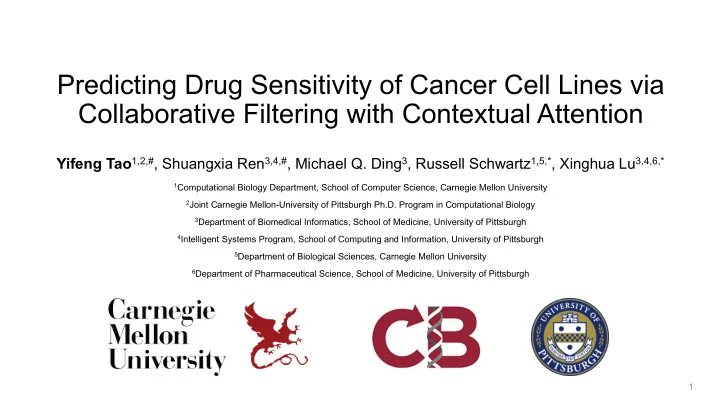

Predicting Drug Sensitivity of Cancer Cell Lines via Collaborative Filtering with Contextual Attention Yifeng Tao 1,2,# , Shuangxia Ren 3,4,# , Michael Q. Ding 3 , Russell Schwartz 1,5,* , Xinghua Lu 3,4,6,* 1 Computational Biology Department, School of Computer Science, Carnegie Mellon University 2 Joint Carnegie Mellon-University of Pittsburgh Ph.D. Program in Computational Biology 3 Department of Biomedical Informatics, School of Medicine, University of Pittsburgh 4 Intelligent Systems Program, School of Computing and Information, University of Pittsburgh 5 Department of Biological Sciences, Carnegie Mellon University 6 Department of Pharmaceutical Science, School of Medicine, University of Pittsburgh 1
Anti-cancer drug recommendation • Tumor resistance to drugs is complex • Both inter- and intra- tumor heterogeneities (Schwartz and Schäffer, 2017) . • Patients of same cancer type may have distinct prognoses (Priedigkeit et al. 2017) . • Large scale cancer cell line assays • NCI-60 (Shoemaker 2006) , CCLE (Barretinna et al. 2012) , GDSC (Yang et al. 2013) etc. • Screening of cell line resistance to a panel of potential drugs. • Molecular profiles of cell lines. 2
Existing work and challenges • Existing methods • Classical machine learning models: Elastic net (Yuan et al. 2016) , Bayesian (Gonen and Margolin 2014) etc. • Cell line or drug similarity: Network (Wei et al. 2019) , collaborative filtering (Liu et al. 2018) etc. • Deep learning models: MLP (Ding et al. 2018) , DeepDR (Chiu et al. 2019) etc. • Challenges in predicting drug response of cancer cell lines • Robustness: noise. • Contextual effects: gene interactions. • Interpretability: biomarkers. 3
Methods • CADRE: Contextual Attention-based Drug REsponse • Collaborative filtering: copes with noisy data. • Attention mechanism: improves interpretability and performance. • Pretrained gene embeddings: boosts performance further. 4
Overall architecture: Collaborative filtering 5
SADRE: Self-Attention-based Drug REsponse • Cell embedding is the weighted sum of gene embeddings: • Self-attention implemented as a sub-neural network: 6
CADRE: Contextual Attention-based Drug REsponse • Drug pathway knowledge is integrated. 7
Pretraining gene embeddings • Gene embedding pretrained using gene2vec, a variant of word2vec, on GEO. • Co-occurrence pattern. Leiserson et al. 2015; Mikolov et al. 2013 8
Results: Performance • Outperforms competing models GDSC dataset CCLE dataset 73 64 72 62 71 60 70 58 AUPR AUPR 69 56 68 54 67 52 66 50 65 48 64 46 E E R g n E R g n E n i n i R R R R D a D a i i r r r D D r D D p p e t e t e e e e A A A A t t l r l r e e i S C i S C p p f f D D ∆ ∆ e e v E v E i i R R t t a a D D r r o o A A b b C C a a l l l l o o C C 9
Effective attention-encoded cell line representation • Major improvements from AUPR per drug… 10
Effective attention-encoded cell line representation 11
Identifies critical biomarkers related to drug resistance • CADRE identifies critical biomarkers related to drug resistance • Two enriched pathways • Export from cell • Signaling receptor binding 12
Conclusions and future directions • Conclusions: • CADRE integrates the attention mechanism into the collaborative filtering framework. • Outperforms competing models in predicting drug responses from RNA profiles of cell lines. • Effective attention-encoded cell line representation. • Identifies critical biomarkers related to drug resistance. • Future directions • Drug recommendation in vivo : intra-tumor heterogeneity. • Better drug feature representation. 13
Acknowledgment • Prof. Xinghua Lu • Prof. Russell Schwartz • Shuangxia Ren • Michael Q. Ding 14
Recommend
More recommend